I have simplified the volume highlighted in the picture into two curves by tracing the footprint in Rhino cutting out reentry bits and ending up with two not quite rectangular closed polylines. When imported into Grasshopper (CRV + EXTrude +CAP) they are identified as having no faulty geometry and no non-convex surfaces. They are imported and processed happily by Split2Floors Component. However, having looked carefully at the Split2Floors component to see that it should identify the inner geometry as a courtyard, what I am observing is that the inner “courtyard” and the outer structure are being filled with floors and zones - the courtyard structure is not recognised. I did try the alternative (and advised against in the component documentation) of cutting a hole in the surface defined by the outer shape using the inner one. This also did not work.
Here is my pared down tutorial file for my students that is at present not functioning…
Any help welcomed.
I have attached a picture of the geometry, the basic geometry and the test / demo file…
test.3dm (35.8 KB)
simple_honeybee_analysis.gh (519.9 KB)
Any and all help welcomed. As usual I strongly suspect the issue is my unfamiliarity with Rhino…
M

